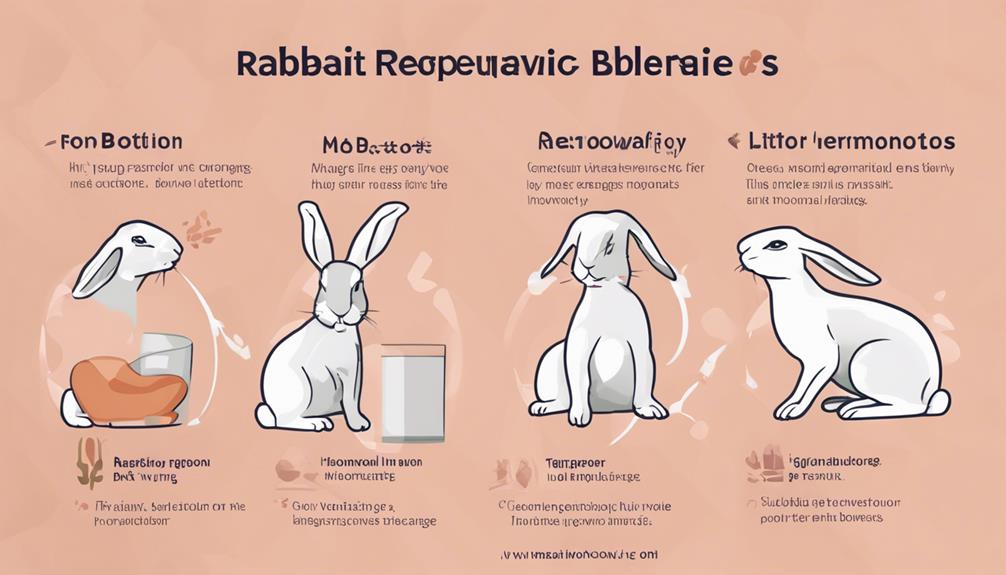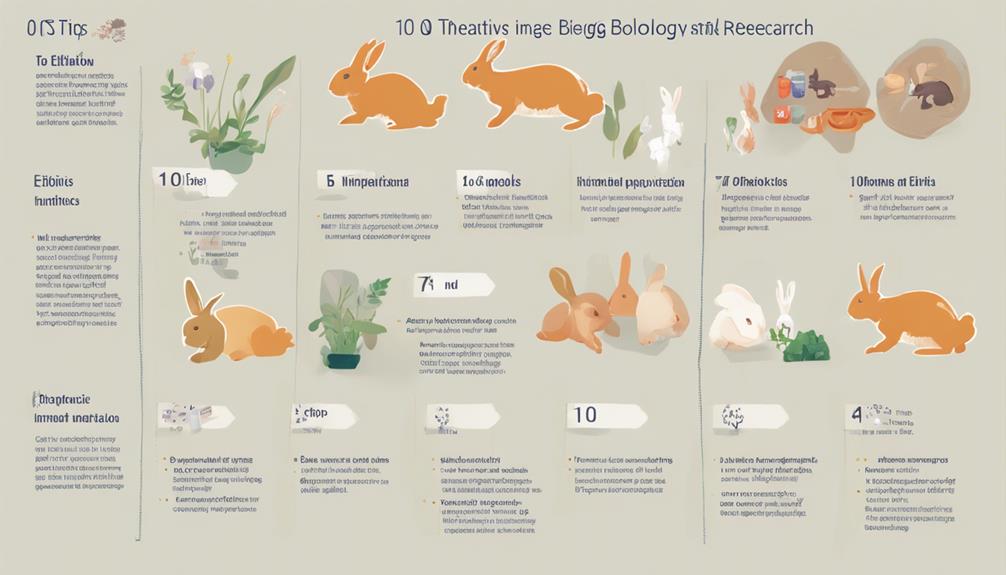Top 10 Tips for Rabbit Biology in Scientific Research
In scientific research, remember these key tips for rabbit biology: 1) Understand their respiratory system for precise control. 2) Acknowledge their hindgut fermentation in the cecum for nutrient extraction. 3) Recognize their complex hierarchies and stress indicators in behavior. 4) Provide ample space and enrichment for natural behaviors. 5) Offer a high-fiber diet with quality feed and supplements. 6) Handle gently to minimize stress and ensure safety. 7) Work with a veterinarian for tailored care. 8) Consider reproductive biology and genetic factors for reliability. 9) Prioritize ethical guidelines and animal welfare. By following these tips, you'll excel in rabbit research practices.
Importance of Rabbit Physiology
Understanding the intricate physiology of rabbits is crucial for comprehending their role in scientific research. When it comes to the respiratory system, rabbits possess a unique set of adaptations that make them ideal for certain types of experiments. Their respiratory rate is relatively high, ranging from 30 to 60 breaths per minute, allowing for efficient oxygen exchange in their lungs. Additionally, rabbits have a well-developed diaphragm, enabling them to control the volume of air in their lungs more precisely than many other small mammals. This respiratory efficiency is vital in studies that require precise control over oxygen levels or respiratory responses.
Moving on to digestive physiology, rabbits are hindgut fermenters, meaning that the majority of their fermentation occurs in the cecum, a pouch-like structure located at the junction of the small and large intestines. This unique digestive system allows rabbits to efficiently extract nutrients from fibrous plant material, making them valuable models for studying processes like fermentation, nutrient absorption, and gut microbiota interactions. Researchers can manipulate the rabbit's diet to study how different nutrients or dietary components affect overall health and digestion.
Understanding Rabbit Behavior
Studying rabbit behavior provides valuable insights into their social dynamics, communication methods, and territorial behavior. Rabbits are social animals that establish complex hierarchies within their groups. Understanding their social dynamics can help researchers comprehend how individuals interact, form bonds, and establish dominance. Communication among rabbits is primarily non-verbal, relying on body language, thumping their hind legs, and making soft vocalizations. By decoding these signals, researchers can gain a deeper understanding of rabbit interactions.
Rabbits exhibit stress responses that are crucial to recognize, as chronic stress can impact their health and well-being. Common stress indicators in rabbits include thumping, teeth grinding, decreased grooming, or aggression. By identifying these signs early on, researchers can implement strategies to reduce stress and improve the welfare of rabbits in research settings.
Territorial behavior is another essential aspect of rabbit behavior to consider. Rabbits are known to mark their territory using chin glands and scent glands located under their chin and around their anus. Understanding territorial behavior aids in creating suitable housing environments that cater to rabbits' natural instincts, reducing potential conflicts and promoting their overall well-being. By studying rabbit behavior comprehensively, researchers can enhance the quality of scientific research involving these fascinating animals.
Housing and Environmental Enrichment
To optimize the well-being of rabbits in research settings, it's crucial to carefully design their housing and provide environmental enrichment tailored to their natural behaviors and instincts. When considering enrichment strategies, focus on creating a stimulating environment that encourages the expression of natural behaviors. Introducing items like tunnels, platforms, and chew toys can help keep rabbits mentally engaged and physically active. Additionally, rotating enrichment items regularly can prevent habituation and ensure continued engagement.
Cage design is another critical aspect to consider. Provide rabbits with enough space to move around comfortably, stand on their hind legs, and stretch out fully. A general rule of thumb is to ensure the cage is at least four times the size of the rabbit. Incorporating platforms and ramps can also increase the available space vertically, providing opportunities for rabbits to explore and exercise in different dimensions.
Socialization benefits play a significant role in the well-being of rabbits. Whenever possible, house rabbits in compatible pairs or groups to allow for social interactions. Socialization can reduce stress levels, promote natural behaviors, and improve overall welfare. Additionally, providing exercise opportunities such as access to a larger play area or supervised time outside the cage can help maintain physical health and prevent boredom.
Nutritional Needs of Research Rabbits
Rabbits' nutritional needs in research settings must be meticulously tailored to support their physiological requirements and overall well-being. Meeting their nutritional requirements is crucial for their health and the validity of research outcomes. Research rabbits typically require a diet high in fiber to promote gastrointestinal health. Hay should make up the majority of their diet, providing essential roughage. Additionally, a quality pelleted feed formulated specifically for rabbits can ensure they receive all necessary vitamins and minerals.
When considering the nutritional needs of research rabbits, dietary supplements may be necessary to prevent deficiencies. Vitamin supplements, particularly vitamin C, may be required as rabbits are unable to synthesize this vitamin on their own. Minerals such as calcium and phosphorus should also be carefully balanced in their diet to support bone health and prevent metabolic issues.
It is essential to work closely with a veterinarian or animal nutritionist to develop a nutrition plan tailored to the specific needs of research rabbits. Regular monitoring of their food intake, body condition, and overall health is crucial to ensure they're receiving adequate nutrition. By providing a well-balanced diet and any necessary dietary supplements, researchers can support the well-being of their rabbits and maintain the integrity of their research outcomes.
Handling and Restraint Techniques
When handling research rabbits, it's crucial to employ gentle yet secure techniques to ensure their safety and minimize stress. Stress management is paramount in maintaining the well-being of research rabbits. One effective way to reduce stress during handling is through proper training methods. By acclimating rabbits to human interaction from a young age using positive reinforcement, they can become more comfortable with being handled.
Training methods should focus on desensitizing rabbits to common handling procedures such as being picked up, restrained, or having medical examinations. Positive reinforcement, such as offering treats or verbal praise, can help build trust between the rabbits and the handlers. It's essential to handle rabbits with care and confidence to instill a sense of security in the animals.
When restraining rabbits for procedures, it's important to use techniques that are both secure and gentle. Avoid excessive force that could cause injury or distress. Proper restraint methods can include supporting the rabbit's body securely but without squeezing or restricting their movement too much. Handlers should always be mindful of the rabbit's comfort and well-being during any restraint.
Health Monitoring and Disease Prevention
In maintaining the well-being and reliability of research data, vigilantly monitoring the health of research rabbits and implementing effective disease prevention measures are indispensable components of ethical research practices. Disease surveillance and preventive medicine play crucial roles in ensuring the welfare and quality of research rabbits.
Here are three essential strategies to consider:
- Regular Health Checks: Conduct routine health assessments to identify any signs of illness or abnormal behavior early on. Monitoring parameters such as weight, body condition, fur quality, and behavior can help detect health issues promptly.
- Quarantine Protocols: Implement strict quarantine measures for new rabbits entering the research facility to prevent the spread of infectious diseases. Isolating new arrivals and conducting thorough health screenings before introducing them to the existing population can safeguard the health of all research rabbits.
- Vaccination Programs: Work with a veterinarian to develop a tailored vaccination schedule based on the specific disease risks in your research facility. Vaccinations are a vital aspect of preventive medicine and can significantly reduce the incidence of common infectious diseases among research rabbits.
Reproductive Biology of Rabbits

Exploring the intricate reproductive biology of these fascinating mammals reveals a complex interplay of physiological processes essential for understanding their breeding patterns and fertility. Hormonal regulation plays a crucial role in the reproductive cycle of rabbits. Mating behavior in rabbits is often influenced by the female's estrous cycle, where receptivity to mating is heightened during periods of peak fertility due to hormonal changes.
The fertilization process in rabbits is unique; it occurs internally, with the male depositing sperm directly into the female's reproductive tract. After mating, the sperm travels through the female's oviduct where fertilization takes place. Once fertilized, the embryo implants in the uterus, initiating pregnancy. The pregnancy duration in rabbits typically lasts around 31 days, with variations based on factors like breed and individual characteristics.
Understanding the hormonal regulation, mating behavior, fertilization process, and pregnancy duration is essential for researchers working with rabbit reproductive biology. By delving into these intricate processes, scientists can gain insights into enhancing breeding programs, studying reproductive disorders, and advancing techniques for assisted reproduction. This knowledge empowers researchers to make informed decisions regarding breeding practices and contributes to the overall understanding of rabbit reproductive health and biology.
Anesthesia and Surgical Considerations
Utilizing appropriate anesthesia methods and considering surgical techniques meticulously are paramount in ensuring the well-being and successful outcomes of procedures involving rabbits in scientific research. When handling anesthesia and surgical procedures, it's crucial to prioritize the following:
- Surgical Recovery: After any surgical intervention, the post-operative care and monitoring of rabbits are critical for their recovery. Implementing proper pain management strategies and ensuring a clean and quiet recovery environment can significantly impact the healing process. Monitoring for signs of distress, infection, or complications post-surgery is essential to intervene promptly if needed.
- Anesthetic Protocols: Tailoring anesthetic protocols to the specific needs of rabbits is essential for their safety and welfare during procedures. Factors such as age, weight, health status, and the type of surgery being performed should all be considered when selecting the appropriate anesthesia regimen. Monitoring vital signs throughout the anesthesia process and adjusting anesthesia levels accordingly can help prevent complications and ensure a smooth recovery.
- Equipment and Training: Using high-quality surgical equipment that's suitable for use in rabbits is crucial for the success of procedures. Additionally, ensuring that all personnel involved in the surgery are adequately trained in rabbit-specific surgical techniques and anesthesia administration is vital for minimizing risks and ensuring the best possible outcomes for the research subjects.
Genetic Considerations in Rabbit Research

Consider carefully the genetic background of rabbits utilized in research studies to ensure the reliability and relevance of experimental outcomes. Understanding the inheritance patterns within the rabbit population is crucial for designing experiments that yield meaningful results. When selecting rabbits for research, it's essential to consider their genetic makeup, as certain traits may impact the outcomes of the study. By taking into account the inheritance patterns of specific traits, researchers can control for genetic variability and reduce confounding factors in their experiments.
In the realm of genetic engineering, rabbits have been used as model organisms for various studies. Genetic engineering techniques allow researchers to modify the rabbit genome to investigate the function of specific genes or to create animal models of human diseases. These genetically modified rabbits can provide valuable insights into the role of genes in health and disease. However, it's important to consider the potential implications of genetic engineering on the welfare of the rabbits involved in research studies.
Ethical Considerations in Rabbit Studies
Ethical concerns arise in rabbit studies due to the necessity of balancing scientific advancement with the welfare of the research subjects. When conducting research with rabbits, it's crucial to adhere to ethical guidelines and prioritize animal welfare to ensure the humane treatment of these animals.
Here are three key considerations to keep in mind:
- Ethical Guidelines: Follow established ethical guidelines and regulations set forth by governing bodies to ensure that the research involving rabbits is conducted in an ethical manner. This includes obtaining proper approvals, minimizing suffering, and utilizing alternatives to animal testing whenever possible.
- Animal Welfare: Prioritize the well-being of the rabbits involved in the study by providing appropriate housing, nutrition, and veterinary care. Regular monitoring of the animals' health and behavior is essential to detect any signs of distress or pain promptly.
- Humane Endpoints: Establish humane endpoints to minimize any potential suffering experienced by the rabbits during the study. Implementing criteria that define when an animal should be removed from the study or euthanized is crucial to prevent unnecessary harm.
Frequently Asked Questions
Can Rabbits Be Trained for Specific Research Tasks?
Yes, rabbits can be trained for specific research tasks using positive reinforcement and clicker training methods. Success rates vary but can be high with consistent training.
Ethical implications should be considered, as training may cause stress. Long term effects on the rabbits' well-being should also be monitored.
Do Rabbits Exhibit Social Hierarchies in Group Housing?
In group housing, rabbits exhibit social hierarchies. Dominance behavior and aggression can be observed as rabbits establish their positions within the group.
Social bonding is also evident through activities like grooming, which helps strengthen their relationships. Understanding these dynamics is crucial for maintaining a harmonious environment among the rabbits.
How Do You Prevent Obesity in Research Rabbits?
To prevent obesity in research rabbits, you should implement dietary restrictions and exercise routines. Monitor their weight regularly and adjust their food intake accordingly.
Providing opportunities for physical activity and mental stimulation is crucial. By managing their weight and health effectively, you can help prevent obesity-related issues in your rabbits.
Remember to consult with a veterinarian for specific guidance tailored to your rabbits' individual needs.
What Are the Best Practices for Transporting Research Rabbits?
When transporting research rabbits, it's crucial to follow strict transportation protocols to ensure their well-being. Proper stress management techniques, like providing a comfortable and secure carrier, can help minimize the impact of transportation on the rabbits.
Maintaining a stable environment with adequate ventilation and temperature control is essential. Handling rabbits gently and avoiding sudden movements can also help reduce stress during transport. By prioritizing their safety and comfort, you can ensure a smooth transportation process.
Are There Specific Considerations for Breeding Research Rabbits?
When breeding research rabbits, you may face various challenges. Genetic selection is crucial to ensure desired traits are passed down. Consider factors like inbreeding risks, genetic diversity, and the overall health of the offspring.
Proper record-keeping is essential for tracking lineage and avoiding genetic issues. Regular health checks and consultations with experts can help you navigate breeding challenges effectively.
Prioritize genetic diversity and health when selecting rabbits for breeding in scientific research.
Conclusion
In conclusion, mastering the key principles of rabbit biology is crucial for successful scientific research.
By understanding their physiology, behavior, and nutritional needs, as well as implementing proper housing and enrichment, handling techniques, and ethical considerations, researchers can ensure the well-being and accurate results of their rabbit studies.
By following these top 10 tips, you can enhance the quality and reliability of your research involving rabbits.
